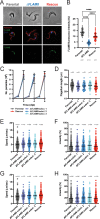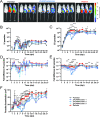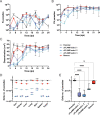FLAgellum Member 8 modulates extravascular distribution of African trypanosomes
- PMID: 38127941
- PMCID: PMC10769064
- DOI: 10.1371/journal.ppat.1011220
FLAgellum Member 8 modulates extravascular distribution of African trypanosomes
Abstract
In the mammalian host, the biology of tissue-dwelling Trypanosoma brucei parasites is not completely understood, especially the mechanisms involved in their extravascular colonization. The trypanosome flagellum is an essential organelle in multiple aspects of the parasites' development. The flagellar protein termed FLAgellar Member 8 (FLAM8) acts as a docking platform for a pool of cyclic AMP response protein 3 (CARP3) that is involved in signaling. FLAM8 exhibits a stage-specific distribution suggesting specific functions in the mammalian and vector stages of the parasite. Analyses of knockdown and knockout trypanosomes in their mammalian forms demonstrated that FLAM8 is not essential in vitro for survival, growth, motility and stumpy differentiation. Functional investigations in experimental infections showed that FLAM8-deprived trypanosomes can establish and maintain an infection in the blood circulation and differentiate into insect transmissible forms. However, quantitative bioluminescence imaging and gene expression analysis revealed that FLAM8-null parasites exhibit a significantly impaired dissemination in the extravascular compartment, that is restored by the addition of a single rescue copy of FLAM8. In vitro trans-endothelial migration assays revealed significant defects in trypanosomes lacking FLAM8. FLAM8 is the first flagellar component shown to modulate T. brucei distribution in the host tissues, possibly through sensing functions, contributing to the maintenance of extravascular parasite populations in mammalian anatomical niches, especially in the skin.
Copyright: © 2023 Calvo-Alvarez et al. This is an open access article distributed under the terms of the Creative Commons Attribution License, which permits unrestricted use, distribution, and reproduction in any medium, provided the original author and source are credited.
Conflict of interest statement
The authors have declared that no competing interests exist.
Figures






Similar articles
-
Redistribution of FLAgellar Member 8 during the trypanosome life cycle: Consequences for cell fate prediction.Cell Microbiol. 2021 Sep;23(9):e13347. doi: 10.1111/cmi.13347. Epub 2021 May 14. Cell Microbiol. 2021. PMID: 33896083 Free PMC article.
-
Independent analysis of the flagellum surface and matrix proteomes provides insight into flagellum signaling in mammalian-infectious Trypanosoma brucei.Mol Cell Proteomics. 2011 Oct;10(10):M111.010538. doi: 10.1074/mcp.M111.010538. Epub 2011 Jun 19. Mol Cell Proteomics. 2011. PMID: 21685506 Free PMC article.
-
TFPP: an SVM-based tool for recognizing flagellar proteins in Trypanosoma brucei.PLoS One. 2013;8(1):e54032. doi: 10.1371/journal.pone.0054032. Epub 2013 Jan 17. PLoS One. 2013. PMID: 23349782 Free PMC article.
-
Parasites in motion: flagellum-driven cell motility in African trypanosomes.Curr Opin Microbiol. 2010 Aug;13(4):459-65. doi: 10.1016/j.mib.2010.05.015. Epub 2010 Jun 28. Curr Opin Microbiol. 2010. PMID: 20591724 Free PMC article. Review.
-
The trypanosome flagellar pocket.Nat Rev Microbiol. 2009 Nov;7(11):775-86. doi: 10.1038/nrmicro2221. Epub 2009 Oct 6. Nat Rev Microbiol. 2009. PMID: 19806154 Review.
Cited by
-
Prevalence of dermal trypanosomes in suspected and confirmed cases of gambiense human African trypanosomiasis in Guinea.PLoS Negl Trop Dis. 2024 Aug 19;18(8):e0012436. doi: 10.1371/journal.pntd.0012436. eCollection 2024 Aug. PLoS Negl Trop Dis. 2024. PMID: 39159265 Free PMC article.
-
Structure, function and druggability of the African trypanosome flagellum.J Cell Physiol. 2022 Jun;237(6):2654-2667. doi: 10.1002/jcp.30778. Epub 2022 May 26. J Cell Physiol. 2022. PMID: 35616248 Free PMC article. Review.
-
Dermal trypanosomes in seropositive suspects of gambiense human African trypanosomiasis in Côte d'Ivoire.PLoS Negl Trop Dis. 2025 Aug 25;19(8):e0013027. doi: 10.1371/journal.pntd.0013027. eCollection 2025 Aug. PLoS Negl Trop Dis. 2025. PMID: 40853995 Free PMC article.
-
A sticky situation: When trypanosomatids attach to insect tissues.PLoS Pathog. 2023 Dec 21;19(12):e1011854. doi: 10.1371/journal.ppat.1011854. eCollection 2023 Dec. PLoS Pathog. 2023. PMID: 38128049 Free PMC article. Review.

